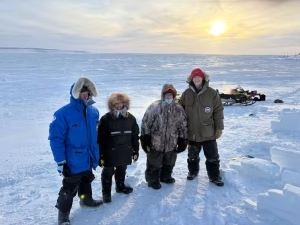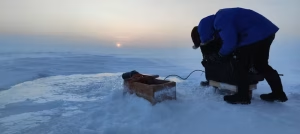By Shaun Fitzgerald, University of Cambridge
Like ice in a drink, Arctic sea ice keeps things cold – until it melts. Using the same principle, some scientists are investigating whether they can make sea ice thicker and better able to cool the planet. I recently returned from Cambridge Bay in the far north of Canada, where I saw some early experiments in practice.
Over the winter months, the build-up of sea ice around Cambridge Bay and across the Arctic helps keep the sea water underneath close to the freezing temperature, which for saltwater is around -1.8°C.
These conditions are broadly maintained even through the early summer until the ice begins to melt and break up. The white ice cover, which reflects a large portion of the sun’s energy, is then replaced by dark blue water, which has the opposite effect. Now absorbing more sunlight, the water warms up.

Such has been the balanced perennial cycle of sea ice in the Arctic, but recent decades of global warming might be putting it in jeopardy.
Over the past 30 years, sea ice in the Arctic has decreased. Rising air temperatures coupled with warmer water flowing in from further south have meant the ice starts to form later in the year and melt earlier.
With less sea ice, there are longer periods in summer where more of the sun’s energy is absorbed rather than reflected into space. This creates a feedback loop – the warmer the water, the less sea ice is formed; the less sea ice there is, the warmer it gets.
My trip to Cambridge Bay was as part of a team of scientists and engineers who have gathered together with local communities in the Arctic and two umbrella projects: Real Ice and Arctic Reflections. These groups want to research whether anything can be done to temporarily slow down or even reverse the loss of sea ice.
The ultimate solution is, undoubtedly, deep and rapid reductions in greenhouse gas emissions. But with slow progress over the past few decades, additional measures may buy us time.
Buying time
Several big ideas are currently being explored. The first involves pumping seawater on top of existing ice to try and promote ice growth on top of the sea ice.
Usually, any new sea ice that forms naturally does so on the underside of the ice. The process of freezing gives off some energy, which must escape through the ice above – a good insulator.

The idea of pumping on top of the ice is that by bypassing the insulating effect, more sea ice might form – and the heat it gives off can be transferred to the cold winter Arctic air or directly radiated out to space.
The second idea stems from the realization that snow is an even better insulator than ice. The proposal is therefore to pump just enough water onto the snow to flood it.
As it freezes and turns into solid ice, it becomes much more conductive than snow. In turn, this will enable more sea ice to form naturally on the underside of sea ice.
A third idea is derived from the observation that as sea ice melts in the early summer, melt ponds form on the surface. These melt ponds are much darker and absorb more heat than the original ice.
So the idea is to explore whether it might be possible to drill small holes in the ice to drain them, exposing reflective ice and slowing the melt.
These ideas might sound fanciful, but the dramatic changes in the Arctic warrant investigation into interventions that could have an impact sooner than cutting emissions or removing greenhouse gases.
Can we really save sea ice?
Crucially, the research is focused on developing our understanding of these potential ideas. The research could show that they are impractical, unfeasible or would potentially make things worse.
For example, if pumping sea water onto sea ice leads to thicker ice at the end of the winter, that may not be much use if the ice is so much saltier that it melts more quickly.
Therefore, researchers are using a combination of mathematical modelling, laboratory experiments, and limited-scale field experiments to address fundamental questions. A research project funded by the U.K. government has just been launched which includes modelling of thickening of sea ice.
A further one including additional outdoor experiments will be starting soon funded by the U.K.’s Advanced Research and Invention Agency (Aria) as part of its Exploring Climate Cooling program.
These experiments will be conducted in close collaboration with local communities and under Aria’s stringent governance framework, prioritizing safety and environmental monitoring. The goal is to gather essential real-world data to rigorously assess if this intervention warrants further consideration.
The initial results and observations from preliminary field experiments are inconclusive but encouraging. For example, the ice formed by pumping sea water onto sea ice appears to become less salty (and therefore less prone to melting) over a few weeks.
The brine which forms as seawater freezes on the surface is more dense than the ice and appears to migrate downwards through the ice. This seems theoretically plausible, but it is too early in the experiments to be confident in the results.
If this research suggests that thickening sea ice works, then the next step will be to engage with more Arctic locals and various policymakers, and determine whether scaled-up testing of some of these approaches would be appropriate.
Shaun Fitzgerald is director of the Centre for Climate Repair at the University of Cambridge.
This article is republished from The Conversation under a Creative Commons license. Read the original article. Banner photo: The author and colleagues exploring the Canadian Arctic (Real Ice).
Sign up for The Invading Sea newsletter by visiting here. To support The Invading Sea, click here to make a donation. If you are interested in submitting an opinion piece to The Invading Sea, email Editor Nathan Crabbe at nc*****@*au.edu.To learn more about the feedback loop described in this piece, known as polar amplification, watch the video below.



